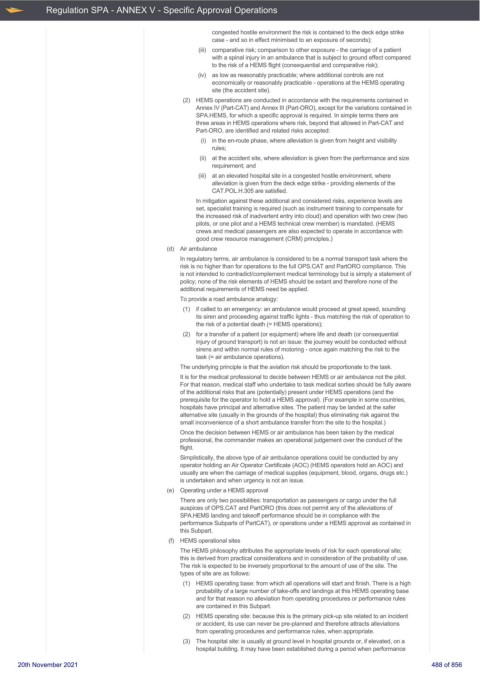Page 488 - UK Air Operations Regulations (Consolidated) 201121
P. 488
~
~ Regulation SPA - ANNEX V - Specific Approval Operations Centrik
congested hostile environment the risk is contained to the deck edge strike
case - and so in effect minimised to an exposure of seconds);
(iii) comparative risk; comparison to other exposure - the carriage of a patient
with a spinal injury in an ambulance that is subject to ground effect compared
to the risk of a HEMS flight (consequential and comparative risk);
(iv) as low as reasonably practicable; where additional controls are not
economically or reasonably practicable - operations at the HEMS operating
site (the accident site).
(2) HEMS operations are conducted in accordance with the requirements contained in
Annex IV (Part-CAT) and Annex III (Part-ORO), except for the variations contained in
SPA.HEMS, for which a specific approval is required. In simple terms there are
three areas in HEMS operations where risk, beyond that allowed in Part-CAT and
Part-ORO, are identified and related risks accepted:
(i) in the en-route phase, where alleviation is given from height and visibility
rules;
(ii) at the accident site, where alleviation is given from the performance and size
requirement; and
(iii) at an elevated hospital site in a congested hostile environment, where
alleviation is given from the deck edge strike - providing elements of the
CAT.POL.H.305 are satisfied.
In mitigation against these additional and considered risks, experience levels are
set, specialist training is required (such as instrument training to compensate for
the increased risk of inadvertent entry into cloud) and operation with two crew (two
pilots, or one pilot and a HEMS technical crew member) is mandated. (HEMS
crews and medical passengers are also expected to operate in accordance with
good crew resource management (CRM) principles.)
(d) Air ambulance
In regulatory terms, air ambulance is considered to be a normal transport task where the
risk is no higher than for operations to the full OPS.CAT and PartORO compliance. This
is not intended to contradict/complement medical terminology but is simply a statement of
policy; none of the risk elements of HEMS should be extant and therefore none of the
additional requirements of HEMS need be applied.
To provide a road ambulance analogy:
(1) if called to an emergency: an ambulance would proceed at great speed, sounding
its siren and proceeding against traffic lights - thus matching the risk of operation to
the risk of a potential death (= HEMS operations);
(2) for a transfer of a patient (or equipment) where life and death (or consequential
injury of ground transport) is not an issue: the journey would be conducted without
sirens and within normal rules of motoring - once again matching the risk to the
task (= air ambulance operations).
The underlying principle is that the aviation risk should be proportionate to the task.
It is for the medical professional to decide between HEMS or air ambulance not the pilot.
For that reason, medical staff who undertake to task medical sorties should be fully aware
of the additional risks that are (potentially) present under HEMS operations (and the
prerequisite for the operator to hold a HEMS approval). (For example in some countries,
hospitals have principal and alternative sites. The patient may be landed at the safer
alternative site (usually in the grounds of the hospital) thus eliminating risk against the
small inconvenience of a short ambulance transfer from the site to the hospital.)
Once the decision between HEMS or air ambulance has been taken by the medical
professional, the commander makes an operational judgement over the conduct of the
flight.
Simplistically, the above type of air ambulance operations could be conducted by any
operator holding an Air Operator Certificate (AOC) (HEMS operators hold an AOC) and
usually are when the carriage of medical supplies (equipment, blood, organs, drugs etc.)
is undertaken and when urgency is not an issue.
(e) Operating under a HEMS approval
There are only two possibilities: transportation as passengers or cargo under the full
auspices of OPS.CAT and PartORO (this does not permit any of the alleviations of
SPA.HEMS landing and takeoff performance should be in compliance with the
performance Subparts of PartCAT), or operations under a HEMS approval as contained in
this Subpart.
(f) HEMS operational sites
The HEMS philosophy attributes the appropriate levels of risk for each operational site;
this is derived from practical considerations and in consideration of the probability of use.
The risk is expected to be inversely proportional to the amount of use of the site. The
types of site are as follows:
(1) HEMS operating base: from which all operations will start and finish. There is a high
probability of a large number of take-offs and landings at this HEMS operating base
and for that reason no alleviation from operating procedures or performance rules
are contained in this Subpart.
(2) HEMS operating site: because this is the primary pick-up site related to an incident
or accident, its use can never be pre-planned and therefore attracts alleviations
from operating procedures and performance rules, when appropriate.
(3) The hospital site: is usually at ground level in hospital grounds or, if elevated, on a
hospital building. It may have been established during a period when performance
20th November 2021 488 of 856

